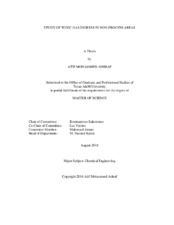| dc.description.abstract | Although the majority of incidents involving toxic gas release in process industries occur outdoors, nearby buildings and its indoor environments are also at high risk. Particularly, non-process areas such as administration buildings are often the least protected, even though they are in the vicinity of potential sources. In literature, indoor exposure modelling techniques range from simple statistical regression and mass balance approaches to more complex models such as multi-zone and computational fluid dynamics (CFD). Therefore, to study toxic gas infiltration, a proper selection of models is required. Despite the significant risk posed by such events in process facilities, there is still a lack of data and comparative studies concerning the appropriate models and mitigation methods.
This work investigates a realistic pipeline leak in a natural gas facility and the subsequent H2S exposure of the nearby administration building. A comparative study is performed by utilizing a dispersion model (SLAB), a multi-zone model (CONTAM) and a CFD model (Quick Urban and Industrial Complex – QUIC). The influence of ventilation network, wind speed, direction, and pressure on toxic gas ingress is examined. Furthermore, the sensitivity of wind pressure calculation on the toxic gas infiltration rate by using American Society of Heating, Refrigerating, and Air-Conditioning Engineers (ASHRAE) correlation and CFD modelling is studied. Indoor toxic levels are attained using combinations of the above mentioned models. Results on indoor toxic levels indicated high sensitivity to wind characteristics which led to varying risks and conclusions. A detailed description of different scenarios and findings is also presented. | en |


